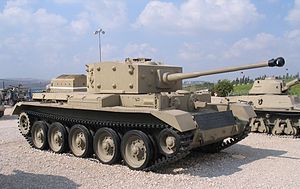Cromwell (tank)
| Cromwell | |
|---|---|

Cromwell in an Israeli military museum (cannon not original) |
|
| General properties | |
| crew | 5 (commander, driver, gunner, loader, machine gunner) |
| length | 6.42 m |
| width | 2.91 m |
| height | 2.51 m |
| Dimensions | 24 to 28 tons |
| Armor and armament | |
| Armor | 8–76 mm (Mk VII 8–102 mm) |
| Main armament | 75 mm L / 36.5 cannon (Mk IV) |
| Secondary armament | 2 × 7.92mm Besa machine guns (one in the hull, one coaxial) |
| agility | |
| drive | V12 petrol engine Rolls-Royce Meteor 600 PS (441 kW) |
| suspension | Christie Drive |
| Top speed | 64 km / h |
| Power / weight | 17.2 kW / t (23.4 PS / t) |
| Range | 280 km |
The Cruiser Tank Mk VIII A 27M Cromwell (Cromwell Cruiser Tank) was a British tank of the Second World War . It was named after the British revolutionary leader and military dictator Oliver Cromwell . The Cromwell and its less motorized variant Centaur were based on the Crusader and formed the basis for the Comet .
development
The Cromwell was built from 1941 upon a request from the British General Staff. Building on the experience with the Crusader, the armor was reinforced to up to 76 mm. The Cromwell was therefore significantly heavier than the Crusader, but made up for the additional weight with a 600 hp Rolls-Royce Meteor engine (the V12 Meteor was the first reliable engine in a British tank). This made it the fastest British tank of the war years. Due to the disproportionately strong wear on the suspension, the top speed was ultimately reduced to 52 km / h in favor of maintenance. Series production began in January 1943 (at Leyland Motors ).
A version of the Cromwell, equipped with the weaker 300 to 390 hp Liberty engine due to production-related bottlenecks , was named Centaur . As early as July 1943, this variant was classified as unsuitable for the front because of high failure rates due to technical defects and because of its under-motorization. The Centaur production finally ended in 1944, remaining Centaur were transferred to training units converted to anti-aircraft tanks and, in some cases with a 95-mm howitzer for infantry support units of the Armored Support Group of the Royal Marines given.
variants

Cromwell
The Cromwell Mk I to III had a 6 pounder cannon (57 mm). The Cromwell Mk IV was introduced in October 1943 and had a 75mm cannon that was ammunition compatible with that of the American M4 Sherman . The Mk V and Mk VII versions also had this cannon. The versions also differed in whether the tubs were welded or riveted. In addition, details such as the chain width and the attachment of the hatches and stowage boxes varied. Other variants have included Cromwell ARV ( English Armored Recovery Vehicle , armored recovery vehicle), Cromwell OP (mobile command vehicle and artillery observation post). The Cromwell proved itself due to its outstanding mobility, but was inferior to most German tanks in terms of armament and armor. An exception was the Mk VII version, whose front armor was reinforced to 102 mm. As with all British tanks of the Second World War, the commander had a Vickers 360 ° angle mirror MK.IV to observe the battlefield under armor protection.
Centaur
- Centaur Mk I QF-6 pounder
- Centaur Mk II revised chains
- Centaur Mk III with Ordnance QF-75-mm
- Centaur Mk IV with Ordnance QF 95mm howitzer
- Centaur AA flak tank with twin 20 mm flak
commitment
The Cromwell tank took part in some important fighting in the British 7th Armored Division . It was not a big step forward, as it had no sloping armor, but due to its motorization, it had a considerable speed on the battlefield. The penetration performance of the 75-mm cannon remained unsatisfactory, so that in subsequent models with the 17-pounder a specialized anti-tank cannon was used as the main armament (including the Sherman Firefly and Challenger ).
See also: British Military Vehicles of World War II
literature
- Alexander Lüdeke: Allied tanks. Motorbuch, Stuttgart 2010, ISBN 978-3-613-03108-1 .
Web links
Individual evidence
- ^ Benjamin Coombs: British Tank Production and the War Economy, 1934-1945. Bloomsbury Academic, 2015, ISBN 978-1-4742-2790-2 , p. 55.
